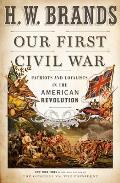Giving the Loyalists Their Due and Then Some
Yesterday’s Boston Globe included a review of one of at least three overviews of the American Revolution published this season: H. W. Brands’s Our First Civil War: Patriots and Loyalists in the American Revolution.
Brands holds a named chair in the History Department at the University of Texas at Austin. His dissertation and early books were about the Cold War, but he moved to earlier periods in U.S. history. Among his many books is The First American, a biography of Benjamin Franklin.
Reviewer David M. Shribman says Brands’s book “turns upside down the view of the struggle” that we usually see, mostly by treating the Loyalists as equally patriotic in their way.
In the last two decades there have been several scholarly books about Loyalists and how they saw the conflict. The observation that the Revolutionary War was in many ways a civil war, as many adherents of the Crown termed it at the time, has become common. In fact, the phrase “our first Civil War” appears in writing by Edward Everett Hale and Charles H. Levermore in the late nineteenth century, during the first period of sympathy for the Loyalists.
Brands might well give equal space or sympathy to the Loyalists, which would be unusual in an overview for general readers. In other respects, Our First Civil War appears to be rather traditional. It follows some of the biggest names of the Revolution, all upper-class white men: Franklin, George Washington, John Adams, Benedict Arnold, Thomas Hutchinson, Joseph Galloway, and William Franklin.
As for local issues, Shribman writes:
As for the sentence about “Respect for order and the rule of law” quoted from the book, that was how Loyalists saw the situation in Boston. But as a historical judgment it’s missing how Bostonians saw themselves as enforcing local order against people who were violating the British constitution. The issue wasn’t “rule of law”; it was which level of government overruled the other. For importers and other friends of the royal government in 1770, the worry wasn’t “unruly mobs”; it was ruly ones.
Brands holds a named chair in the History Department at the University of Texas at Austin. His dissertation and early books were about the Cold War, but he moved to earlier periods in U.S. history. Among his many books is The First American, a biography of Benjamin Franklin.
Reviewer David M. Shribman says Brands’s book “turns upside down the view of the struggle” that we usually see, mostly by treating the Loyalists as equally patriotic in their way.
In the last two decades there have been several scholarly books about Loyalists and how they saw the conflict. The observation that the Revolutionary War was in many ways a civil war, as many adherents of the Crown termed it at the time, has become common. In fact, the phrase “our first Civil War” appears in writing by Edward Everett Hale and Charles H. Levermore in the late nineteenth century, during the first period of sympathy for the Loyalists.
Brands might well give equal space or sympathy to the Loyalists, which would be unusual in an overview for general readers. In other respects, Our First Civil War appears to be rather traditional. It follows some of the biggest names of the Revolution, all upper-class white men: Franklin, George Washington, John Adams, Benedict Arnold, Thomas Hutchinson, Joseph Galloway, and William Franklin.
As for local issues, Shribman writes:
Brands characterizes both George Washington of Virginia and Benjamin Franklin of Pennsylvania as moderates in comparison with the radicals of Massachusetts. He describes Boston as “the hotbed of resistance to British authority.”In fact, that last sentence doesn’t express a fact at all. As I wrote in this 2013 article, I haven’t found the words “Intolerable Acts” in any Revolutionary writings, much less in many of them. The label surfaced first in U.S. history textbooks a century after the Revolution. I can’t tell if the phrase appears in Brands’s book, but I’ve seen it in two reviews so far.
But by 1770, tensions in the Bay Colony reached the boiling point, with unruly mobs roaming through Boston, threatening those regarded as sympathetic to British officials. In March came the Boston Massacre, followed three years later by the Boston Tea Party. “Respect for order and the rule of law all but vanished in Boston,” Brands writes.
The mere fact the measure that the Lord North government titled the Coercive Acts was dubbed the Intolerable Acts in America speaks to the widening gap between colony and mother country.
As for the sentence about “Respect for order and the rule of law” quoted from the book, that was how Loyalists saw the situation in Boston. But as a historical judgment it’s missing how Bostonians saw themselves as enforcing local order against people who were violating the British constitution. The issue wasn’t “rule of law”; it was which level of government overruled the other. For importers and other friends of the royal government in 1770, the worry wasn’t “unruly mobs”; it was ruly ones.


1 comment:
That's fascinating about the use of "Intolerable Acts." I had no idea. Thank you.
Post a Comment